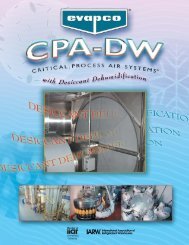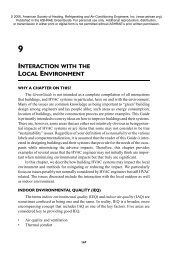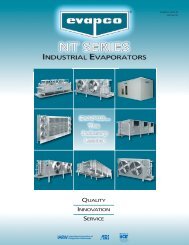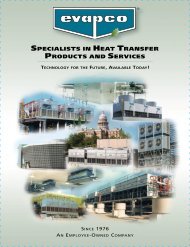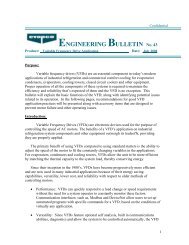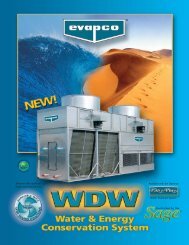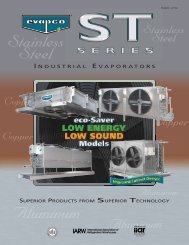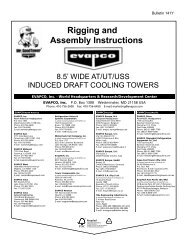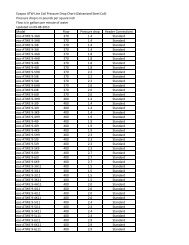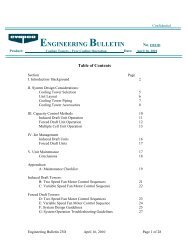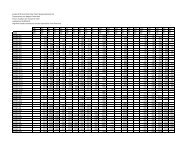The Use of Variable Frequency Drives Engineering Bulletin
The Use of Variable Frequency Drives Engineering Bulletin
The Use of Variable Frequency Drives Engineering Bulletin
You also want an ePaper? Increase the reach of your titles
YUMPU automatically turns print PDFs into web optimized ePapers that Google loves.
Not all resonant frequencies can be determined in advance because the tower’s supporting<br />
structure, external piping and accessories contribute to the overall stiffness <strong>of</strong> the tower.<br />
Discovering resonant frequencies in an operating cooling tower does not necessarily indicate a<br />
cooling tower design defect; but rather, a failure to perform appropriate systems checks. This<br />
may cause premature equipment failure.<br />
<strong>The</strong> VFD drive must also be adjusted so that the tower’s fan drive train does not experience<br />
cogging or torque ripple. <strong>The</strong>se torque fluctuations can occur at various frequencies over the<br />
operating speed range (ref. MG-1 Part 30, sect. 30.02.2.8) 2 . If the cogging cannot be<br />
controlled with programmable drive settings, the drive should be programmed to skip the<br />
troublesome frequencies.<br />
To check for other troublesome resonances in the field, a run-up and run-down test needs to be<br />
performed. Starting with the lowest operating frequency, step up fan frequency about 2 Hz at a<br />
time until full speed is reached. At each step, pause long enough for the fan to reach steady<br />
state. Note changes in unit vibration. Ideally, an accelerometer mounted on the bearing plate<br />
should be used to monitor the vibration levels. However great caution must be exercised with<br />
accelerometers. <strong>The</strong>y are highly susceptible to electrical noise from the VFD, which creates<br />
both random and periodic spikes in the vibration spectrum.<br />
If a “rough” or loud operating condition is encountered, quickly skip frequencies until the<br />
condition subsides. Note the beginning and ending band <strong>of</strong> the rough frequency range.<br />
Continue stepping through frequencies until full speed is reached. Repeat this process in<br />
reverse by stepping back down the frequency range to minimum speed. Some frequencies not<br />
detected on acceleration will arise on deceleration. Isolate the troublesome spots and approach<br />
them carefully from the top and bottom to try to determine the “edge” <strong>of</strong> onset. After the<br />
problem frequencies have been identified, a 2 Hz safety band on either side should be added<br />
and the frequency band programmed into the drive’s lockout.<br />
If a vibration problem is noted over a very wide frequency band(10 hz or greater), there is<br />
likely a problem with the VFD or the mechanical equipment. <strong>The</strong> Evapco Marketing<br />
Department and the drive supplier need to be consulted. Often alleviating the problem is as<br />
simple as correctly programming the VFD’s torque pr<strong>of</strong>iles, carrier frequencies, and smoothing<br />
parameters. Persistent problems need further attention from Evapco and the drive<br />
manufacturer.<br />
Motor noise or whine can be a serious problem with VFD’s in sound sensitive locations. VFD<br />
driven motors normally exhibit a sharp tonal noise somewhere in the 2-8 kHz band that is 5-10<br />
dB higher than the background sound levels. <strong>The</strong> noise does not indicate a motor problem.<br />
<strong>The</strong> noise is a consequence <strong>of</strong> the VFD’s high frequency power switching. Most drives have<br />
programmable carrier frequencies or tone controls that allow some motor noise reduction. A<br />
higher carrier frequency reduces the audible noise but also reduces the current capability <strong>of</strong> the<br />
drive and increases the voltage spikes in the motor. <strong>The</strong> drive should be field programmed<br />
with the lowest tolerable carrier frequency for maximum drive and motor life.<br />
6



